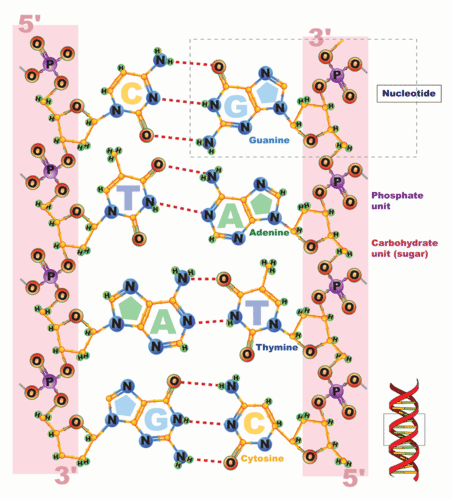1.4: Nucleic Acids
- Page ID
- 8337

You may have heard that something is "encoded in your DNA." What does that mean?
Nucleic acids. Essentially the "instructions" or "blueprints" of life. Deoxyribonucleic acid, or DNA, is the unique blueprints to make the proteins that give you your traits. Half of these blueprints come from your mother, and half from your father. Therefore, every person that has ever lived - except for identical twins - has his or her own unique set of blueprints - or instructions - or DNA.
Nucleic Acids
A nucleic acid is an organic compound, such as DNA or RNA, that is built of small units called nucleotides. Many nucleotides bind together to form a chain called a polynucleotide. The nucleic acid DNA (deoxyribonucleic acid) consists of two polynucleotide chains. The nucleic acid RNA (ribonucleic acid) consists of just one polynucleotide chain.
Structure of Nucleic Acids
Each nucleotide consists of three smaller molecules:
- sugar
- phosphate group
- nitrogen base
If you look at Figure below, you will see that the sugar of one nucleotide binds to the phosphate group of the next nucleotide. These two molecules alternate to form the backbone of the nucleotide chain. This backbone is known as the sugar-phosphate backbone.
The nitrogen bases in a nucleic acid stick out from the backbone. There are four different types of bases: cytosine (C), adenine (A), guanine (G), and either thymine (T) in DNA, or uracil (U) in RNA. In DNA, bonds form between bases on the two nucleotide chains and hold the chains together. Each type of base binds with just one other type of base: cytosine always binds with guanine, and adenine always binds with thymine. These pairs of bases are called complementary base pairs.
 Nucleic Acid. Sugars and phosphate groups form the backbone of a polynucleotide chain. Hydrogen bonds between complementary bases hold two polynucleotide chains together.
Nucleic Acid. Sugars and phosphate groups form the backbone of a polynucleotide chain. Hydrogen bonds between complementary bases hold two polynucleotide chains together.The binding of complementary bases allows DNA molecules to take their well-known shape, called a double helix, which is shown in Figure below. A double helix is like a spiral staircase. The double helix shape forms naturally and is very strong, making the two polynucleotide chains difficult to break apart.
 DNA Molecule. Bonds between complementary bases help form the double helix of a DNA molecule. The letters A, T, G, and C stand for the bases adenine, thymine, guanine, and cytosine. The sequence of these four bases in DNA is a code that carries instructions for making proteins. Shown is how the DNA winds into a chromosome.
DNA Molecule. Bonds between complementary bases help form the double helix of a DNA molecule. The letters A, T, G, and C stand for the bases adenine, thymine, guanine, and cytosine. The sequence of these four bases in DNA is a code that carries instructions for making proteins. Shown is how the DNA winds into a chromosome.Roles of Nucleic Acids
DNA is also known as the hereditary material or genetic information. It is found in genes, and its sequence of bases makes up a code. Between "starts" and "stops," the code carries instructions for the correct sequence of amino acids in a protein (see Figure below). DNA and RNA have different functions relating to the genetic code and proteins. Like a set of blueprints, DNA contains the genetic instructions for the correct sequence of amino acids in proteins. RNA uses the information in DNA to assemble the correct amino acids and help make the protein. The information in DNA is passed from parent cells to daughter cells whenever cells divide. The information in DNA is also passed from parents to offspring when organisms reproduce. This is how inherited characteristics are passed from one generation to the next.
 The letters G, U, C, and A stand for the bases in RNA. Each group of three bases makes up a code word, and each code word represents one amino acid (represented here by a single letter, such as V, H, or L). A string of code words specifies the sequence of amino acids in a protein.
The letters G, U, C, and A stand for the bases in RNA. Each group of three bases makes up a code word, and each code word represents one amino acid (represented here by a single letter, such as V, H, or L). A string of code words specifies the sequence of amino acids in a protein.Summary
- DNA and RNA are nucleic acids. Nucleic acids are built of small units called nucleotides.
- The bases of DNA are adenine, guanine, cytosine and thymine. In RNA, thymine is replaced by uracil.
- In DNA, A always binds to T, and G always binds to C.
- The shape of the DNA molecule is known as a double helix.
- DNA contains the genetic instructions for the correct sequence of amino acids in proteins. RNA uses the information in DNA to assemble the correct amino acids and help make the protein.
Review
- Identify the three parts of a nucleotide.
- What is DNA?
- What are complementary base pairs? Give an example.
- Describe the shape of DNA.
- How are DNA and RNA related to proteins?
| Image | Reference | Attributions |
 |
[Figure 1] | Credit: Marianna Ruiz Villarreal (LadyofHats) for the CK-12 Foundation;Madeleine Price Ball, modified by CK-12 Foundation Source: CK-12 Foundation ; commons.wikimedia.org/wiki/File:Genetic_code.svg License: Public Domain |
 |
[Figure 2] | Credit: Mariana Ruiz Villarreal (LadyofHats) for CK-12 Foundation;Mariana Ruiz Villarreal (LadyofHats) for the CK-12 Foundation;Image copyright Denis Vrublevski, 2014 Source: CK-12 Foundation ; http://www.shutterstock.com License: CC BY-NC 3.0; Public Domain |
 |
[Figure 3] | Credit: Marianna Ruiz Villarreal (LadyofHats) for the CK-12 Foundation Source: CK-12 Foundation License: CC BY-NC 3.0 |
 |
[Figure 4] | Credit: Madeleine Price Ball, modified by CK-12 Foundation Source: commons.wikimedia.org/wiki/File:Genetic_code.svg License: Public Domain |

